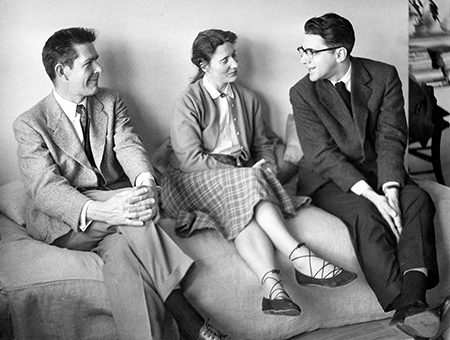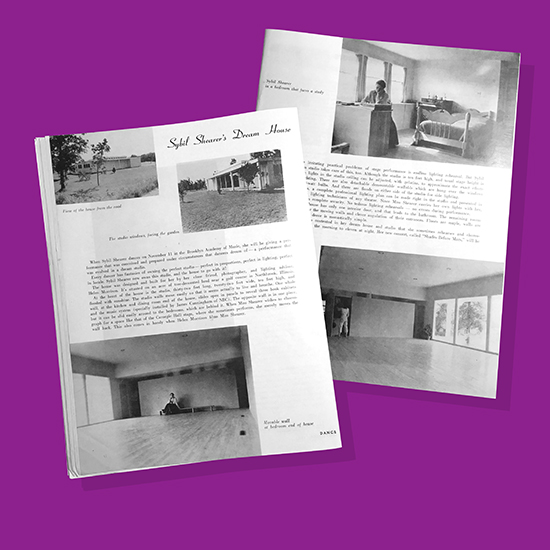
John Cage and David Tudor with Sybil Shearer in her Studio, 1957
Helen was a natural impresario, and she and Sybil had many notable acquaintances. When they presented RUTH ST. DENIS at Roosevelt College in 1946, Miss Ruth stayed with them in Northbrook. Sybil reported that “Helen tried to do a portrait of her. It was impossible. Miss Ruth considered herself the most photographed person in the world, and she had at least 105 poses ready for every time the camera was raised.” In 1948 they presented ELEANOR KING at New Trier High School in Winnetka, with a reception afterwards at the Morrison home.
In 1949 Helen had an idea to host a series, which she called the RONDO. (Jim Cunningham later reported that she got the idea from a 1949 Columbia recording, “Pleasure Dome,” where eight famous poets read their own work.) The first Rondo guest, in January, was UTA HAGEN, then playing in A Streetcar Named Desire. She spoke on “The Artist in Relation to the American Audience” at the Winnetka Community House.
Next came MERCE CUNNINGHAM and JOHN CAGE at the North Shore Country Day School. They were not yet famous, and Sybil enticed them with an offer to choreograph a dance for Merce. In March came pianist WILLIAM MASSELOS, playing Charles Ives’ unusual modern work, First Piano Sonata, in its second performance after its New York premier. Then came FRANK LLOYD WRIGHT, again at New Trier High School. On the drive out, Helen lectured him that he was not just to make an appearance and say a few words. Later RICHARD LIPPOLD created quite a stir, arriving in his padded hearse, which he used to carry his sculptures. His works were hung in the Morrison garden for another stellar event.

Elevation drawing of The Rondo, c. 1950
Helen was serious about continuing the Rondo on a larger scale, and even formed a 501(c)(3) not for profit corporation “To educate the members in the appreciation of the various arts and to stimulate interest in art in all its forms.” She also dreamed up a small facility to house the Rondo – with a tea room and performance space, and had an architect draw up her plan. But it was not to be. In Sybil’s words, “Circumstances were such that we never had another Rondo performance, but actually the five events seemed to make a complete whole.”

Sybil’s Studio featured in Dance Magazine, November 1953
Designer
Architecture was a deep interest for Helen, who had photographed notable architects from FRANK LLOYD WRIGHT to MIES VAN DER ROHE and had worked with ROBERT SEYFARTH in the design of the Morrison residence in Northbrook. In 1951 she decided to design and supervise the building of Sybil’s new studio-residence, after finding no architect whom she felt had any idea what a dancer needed. (According to Sybil, “Her grandfather was an architect and Helen simply did things by instinct and a lot of talking.”) It was rare for any dancer to have a studio-residence like Sybil’s, and it was featured in Dance Magazine in November 1953.
Photography was Helen Morrison’s primary focus, but as her collaboration with Sybil grew, other dimensions of her artistry began to emerge. Besides serving as Sybil’s lighting designer, she next took on stage design in 1957, reworking the space where Sybil’s early group dances were performed at the Winnetka Community House. When Sybil became Artist-in-Residence at the National College of Education in Evanston in 1963, she had full use of their Arnold Theatre with stage dimensions matching those of Carnegie Hall. When the college decided to redo the stage, Helen handled the selection and purchase of all equipment, saving thousands of dollars and creating a perfect setting for Sybil’s company. By 1969 Helen was even listed occasionally as costume designer.
